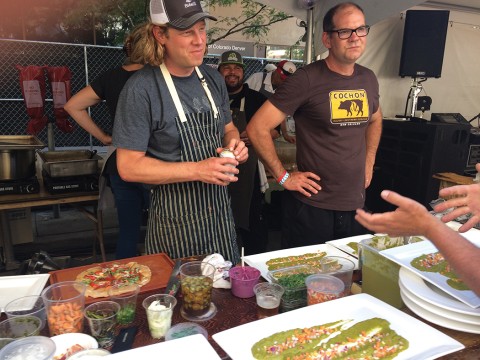A trash-to-table feast at Slow Food Nations
At the conference, chefs cooked for 100 of us using ingredients that were headed for the landfill.

On the cordoned-off street near Denver’s Larimer Square, a dozen chefs worked intently to prepare a dinner for about 100 people. Soon they began sending out plate after plate of gorgeous food: lightly pickled cherry tomatoes, okra, radishes, and turnips; chips and salsa; tuna escabeche; pork barbecue hash and baked beans; fried chicken wings; lentil stew with goat meat; and flatbreads topped with everything from prosciutto, tomatoes, and mozzarella to a bright fuchsia spread made with beet puree, cheese, and whey. And just when we thought we couldn’t possibly eat any more, out came the most perfect peach and cherry cobbler.
How was this meal different from all others? Every single dish was made entirely from garbage. Or, more precisely, “food waste.”
All of the excess food from the hundreds of workshops and conference events preceding the meal, though perfectly edible, would normally have gone straight into a garbage bag, then into a garbage truck, and then to a landfill. That’s what happens every day with food left over from restaurants, grocery stores, office parties, and personal refrigerators. Even the landfill is not a peaceful final resting place for food, as it festers there, releasing greenhouse gases. In fact, food waste is the third-largest source of carbon emissions, according to Food Chain Workers Alliance president Jose Oliva.
Read our latest issue or browse back issues.
So how did all this food waste that I was ravenously enjoying with a hundred other diners manage not go to waste?
The short answer is one person: Steven Satterfield, executive chef and owner of Miller Union in Atlanta, Georgia. Satterfield conceived of, planned, and executed this Zero Waste Family Meal on the final evening of the three-day Slow Food Nations conference in Denver.
The longer answer is that the nonprofit organization behind the event, Slow Food USA, is part of a burgeoning global movement to raise awareness of, and ultimately eliminate, food waste.
“I’ve seen it so many times,” said Satterfield, “at the end of a conference or a big food festival, they’re sending tons of food to landfills.”
Satterfield said the Zero Waste Family Dinner was also a natural extension of the family meals that restaurants typically prepare and serve their staff. “The family meal is based on what we have on hand. We assess what’s in the cooler, decide how to use it, then cook it and serve it up family style.”
The simplicity and frugality of “What do we have, and what can we make with it?” has nearly been lost in the modern prepared-food and fast-food world. According to the Guardian, “Americans throw away almost as much food as they eat because of a ‘cult of perfection,’ deepening hunger and poverty, and inflicting a heavy toll on the environment.”
That half our food is wasted is due not only to our desire for perfect-looking produce. “Food waste is built into a global food system that is designed to fulfill our every whim for any food at any time,” according to Ricardo Salvador, head of the Food and Environment Program at the Union of Concerned Scientists. Salvador explained in his keynote address at Slow Food Nations: “If a grocery store doesn’t have bananas every time a customer comes in looking for them, that customer will go elsewhere. If a fast- food joint doesn’t put lettuce and tomato on the burger or sandwich every time, consumers go elsewhere. And so stores and restaurants overpurchase to ensure the constant availability consumers expect. And then they throw away the excess each and every day.” That systemic food waste is part of the global food system in which all of us are implicated.
The anti-food-waste movement got rolling with Tristram Stuart’s 2009 book Waste: Uncovering the Global Food Scandal and Jonathan Bloom’s 2010 American Wasteland: How America Throws Away Nearly Half of Its Food (and What We Can Do about It). Then the Natural Resources Defense Council issued its 2012 report, Wasted: How America Is Losing up to 40 Percent of Its Food from Farm to Fork to Landfill, which blossomed into a valuable website explaining the problem and what can be done about it.
Soon after the European Union declared 2014 the Year against Food Waste, high-profile chefs in the United States came on board. Dan Barber briefly turned his Blue Hill restaurant in Greenwich Village into “wastED,” a pop-up restaurant that created menus using food normally thrown away. Barber’s waste education and other efforts have raised awareness of food waste and led to films such as Just Eat It, nonprofits such as EndFoodWaste.org and Daily Table in Dorchester, Massachusetts, and businesses such as Imperfect Produce in California.
Although these efforts to address waste are new, the practices and values behind them are ancient. Your mother and grandmother probably told you not to waste food. And religious traditions have enshrined and codified gleaning in order to prevent waste and feed the needy.
Steven Satterfield and his team functioned as modern-day gleaners as they prepared for the Zero Waste Family Dinner at the Slow Food Nations conference. First Satterfield contacted his fellow chefs and others who were hosting the workshops and events at the conference. He told them about the dinner and asked what ingredients they’d be using during the conference, drawing up a spreadsheet so he could begin thinking about the Zero Waste Family Dinner menu.
As the event drew near, he confirmed the ingredients and asked all the participants to set aside and properly store food that they normally would have thrown away. This included scraps such as radish tops, fennel fronds, and fish carcasses, as well as all manner of excess food, from unbaked bread dough to uneaten cheese and meat. Satterfield also contacted all the vendors at Denver’s weekend farmers’ market and told them he’d take their unsold produce, no matter if it was soft, wilted, bruised, cracked, or otherwise less than perfect.
On the day of the Zero Waste Family Dinner, Satterfield’s team sprang into action, gleaning all the food from the farmers’ market, workshops, and meals. Then they met to figure out what to make from it. “Chefs often do their best work under the gun,” Satterfield said. “It’s really fun for us, figuring out what will work.”
Satterfield and his team of chefs from around the country—including Sarah Adams, Daniel Asher, Jamey Fader, Evan Mallett, Alex Seidel, Rebecca Harrigan, Matthew Vawter, John Cox, and Xandre Borghetti—poached tuna carcasses and picked all the meat off, surprised that there was so much meat to recover. They slightly modified the raw bread dough to create a flat bread dough, on which they spread many toppings gleaned from vegetable and meat scraps. And they explored what Satterfield calls “vegetables’ intricacies” in order to make salads from radish greens, fennel fronds, and other vegetable parts not normally used. Finally, they made huge fruit cobblers from the farmers’ market peaches and cherries that were bruised, soft, or otherwise deemed unfit by customers—but absolutely perfect for a cobbler, topped with crispy bits of leftover pastries.
“Using what is so often wasted makes sense on all levels,” Satterfield said, from environmental to economic to moral. “It extends the volume of what we produce out of the kitchen, and it provides more diners with more nutrients and fiber. Using the tops of carrots means less food in the trash and more on plate.” And using what would normally be wasted “sends a unique message to the customer.”
That message came through loud and clear as the Zero Waste Family Dinner progressed and food was sent out to the tables in wave after wave. There was a palpable sense of wonder and joy from chefs and diners alike. The wonder was that abundant and delicious food was being made from waste. The joy was being part of the solution to the food waste problem on this special evening—and from knowing that we could continue to be part of the solution by gathering up the imperfect, using what we have, and doing good while eating well.
A version of this article, which was edited on January 4, 2018, to clarify that Daily Table is a nonprofit rather than a business, appears in the January 17 print edition under the title “Trash to table.”





